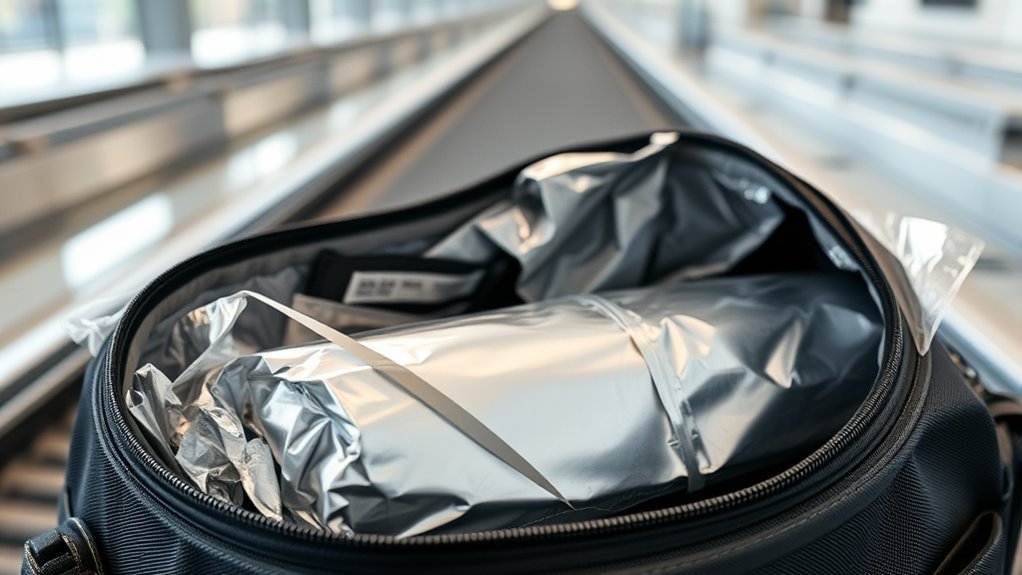To transport foil safely on flights, pack it in a sturdy, flat container or roll large sheets tightly before securing with bands. Wrap it in plastic or resealable bags for protection against moisture and dirt. Carry the foil in your carry-on to prevent damage and make security checks easier, ensuring it’s cushioned to avoid creases or tears. Be sure to check airline policies first; if you stick to these tips, you’ll minimize risks and streamline your journey. More helpful details follow.
Key Takeaways
- Pack foil in a sturdy, flat container or rigid folder to prevent bending and damage.
- Wrap foil in plastic wrap or resealable bags to protect against moisture and dirt.
- Carry foil in your carry-on luggage for better supervision and to avoid damage in checked baggage.
- Roll large sheets tightly and secure with rubber bands before placing in protective tubes or reinforced envelopes.
- Clearly label packages as “fragile” or “craft supplies” to facilitate inspection and prevent mishandling.

Transporting foil on flights requires careful planning to guarantee it arrives intact and meets airline regulations. Whether you’re carrying decorative foil, culinary sheets, or specialty craft materials, proper packaging is essential to prevent damage and avoid delays during security checks. Start by selecting the right packaging tips to ensure your foil stays smooth and uncreased. Use a sturdy, flat container or a rigid folder to keep the foil flat and protected from bending or tearing. Wrapping the foil in plastic wrap or resealable bags can provide an extra layer of security against moisture and dirt, which could compromise its quality or appearance. If you’re transporting large sheets, consider rolling the foil tightly and securing it with rubber bands or tape, then placing it in a protective tube or a reinforced envelope. This approach minimizes creases and keeps the foil in pristine condition.
When preparing to go through security, it’s vital to familiarize yourself with security regulations related to carrying metallic or reflective materials. Although foil generally isn’t prohibited, security personnel may need to inspect it, especially if it’s bulky or resembles concealed items. To streamline the process, clearly label your package as “fragile” or “craft supplies” if applicable, and keep it easily accessible in your carry-on luggage. Avoid packing foil in checked baggage, as it can be damaged or cause confusion during screening. Instead, keep it in your personal bag where you can monitor and quickly address any questions from security agents.
Prior to arriving at the airport, double-check airline policies regarding carrying foil or similar materials, as some airlines might have specific restrictions or guidelines. When packing, ensure your foil is cushioned to prevent creases or tears during handling. Using a layer of bubble wrap or foam padding around the package can absorb shocks and keep the foil flat. If your foil is particularly valuable or delicate, consider carrying it as hand luggage rather than checking it in. Not only does this reduce the risk of damage or loss, but it also allows you to better supervise its security during inspection.
Frequently Asked Questions
Can I Carry Foil in My Carry-On Luggage?
You can carry foil in your carry-on luggage, but foil safety is essential. Make sure it’s well-packaged to prevent tearing or damage, using sturdy wrapping or a protective container. Follow packaging tips like sealing it tightly and keeping it flat to avoid messes or issues at security. Remember, airline policies vary, so check with your airline beforehand to confirm there are no restrictions on carrying foil, especially if it’s for special use or crafts.
Are There Size Restrictions for Foil Packaging?
Imagine flying with a large foil package, only to find it’s too big for security’s packaging regulations. Size restrictions for foil packaging vary by airline and country but generally limit dimensions to ensure foil safety and compliance. Always check with your airline before packing, as exceeding size limits could lead to confiscation or delays. Keep your foil packaging within the permitted dimensions to avoid trouble at security checkpoints.
Should Foil Be Declared During Security Screening?
You should declare foil during security screening to avoid delays or confiscation, considering security scanner limitations and foil packaging regulations. While foil is generally allowed, informing security personnel helps prevent misunderstandings, especially if it’s large or unusual. By declaring it upfront, you guarantee smoother processing. Always check the airline’s specific rules and any country-specific foil regulations before traveling to avoid surprises at the security checkpoint.
Is Foil Allowed in Checked Baggage Without Restrictions?
Picture unwrapping a gift, the shiny foil catching your eye. You can pack foil in checked baggage without restrictions, making it perfect for food packaging or gift wrapping. Just guarantee it’s properly secured to avoid damage or mess. While it’s allowed, remember to declare any suspicious items. With foil safely stowed, your trip becomes smoother, letting you focus on the joy of giving or enjoying your favorite snacks without worry.
What Are the Penalties for Transporting Foil Illegally?
If you illegally smuggle foil, you risk serious Customs penalties, including hefty fines and potential legal trouble. Authorities take illegal smuggling seriously, and getting caught can lead to confiscation of the foil, delays, or even arrest. It is crucial to follow regulations and declare any foil you’re transporting. Avoid penalties by adhering to airline and Customs rules, ensuring your travel remains smooth and trouble-free, and you stay within legal boundaries.
Conclusion
Now that you know the key steps to transporting foil safely, you might think your journey is straightforward. But beware—unexpected security checks or airline policies could still surprise you. One small oversight could cause delays or confiscation, leaving you wondering what went wrong. Stay alert, double-check your packaging, and stay flexible. After all, in the world of air travel, even the best plans can be challenged. Are you ready to face whatever comes next?










